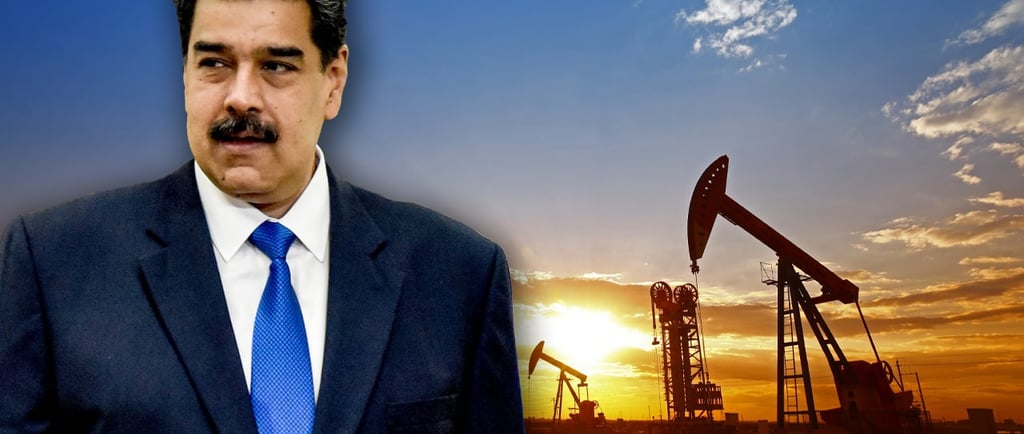Venezuela: Geopolitical Dynamics and Oil Diplomacy
Venezuela’s oil sector has experienced a temporary resurgence following the U.S. easing sanctions in late 2023, allowing its exports to reach a four-year high. Will the ongoing geopolitical tensions and potential reimposition of sanctions threaten Venezuela's fragile recovery in the oil industry?
VENEZUELA
Daria Maiorova
8/10/20247 min read


Venezuela, as a major oil producer, has faced the impact of international sanctions imposed on its oil industry. In October 2023, the United States temporarily eased sanctions on Venezuela’s oil sector for six months, resulting in the country’s oil exports reaching a four-year high of 660,000 barrels per day in February 2024, with approximately one-third of that volume being shipped to the United States.
Despite the prolonged sanctions imposed by Washington on Caracas, particularly those blocking oil imports from the state-owned company PDVSA and access to the U.S. financial system, Venezuela managed to maintain its trading partners in the oil industry. Signs of improving relations between the United States and Venezuela began to emerge as early as November 2022. That same month, in an effort to mitigate the impact of rising global energy prices, the United States allowed Chevron to resume limited operations in Venezuela. In return, the Maduro government and the opposition agreed to resume dialogue after a year-long deadlock.
In October 2023, Caracas adopted a plan to organize free and fair presidential elections in 2024, leading to further easing of sanctions on Venezuela’s oil and gas sector, allowing it to export oil products for six months. However, after Venezuelan authorities failed to meet the conditions for holding fair elections and reignited the longstanding territorial dispute with Guyana over control of the oil-rich Essequibo region, the U.S. reimposed some of the old sanctions in April of the same year.
For a long time, Russia has remained a loyal ally of Venezuela, investing significant amounts in the country’s oil fields. However, the rise in debt, logistics problems, and U.S. sanctions have led to a noticeable decline in Russian oil companies’ activity in the country. In 2020, Roszarubezhneft acquired shares in joint ventures from Rosneft after Washington imposed sanctions on two of Rosneft’s trading units, accusing them of selling Venezuelan oil. Production in the five joint ventures has fallen, as U.S. sanctions have hindered investment and maintenance, and also deterred many buyers of Venezuelan oil. In 2023, independent consultants estimated that these plants produced between 103,000 and 120,000 barrels of oil per day.
In early March 2024, the tanker Ligera, carrying 1.8 million barrels of Russian Urals crude oil, arrived in Venezuelan waters. Ligera had received the Urals oil through ship-to-ship transfer from smaller tankers, such as Nautilus from Novorossiysk and Julia A from Ust-Luga. After loading, the tanker headed to the Caribbean without specifying a particular destination. On February 20, 2024, it arrived at the port of Amuay, where the Amuay, Bajo Grande, and Cardón refineries of the Paraguana complex are located. This delivery marked the first significant shipment of Russian oil to Venezuela in the past five years.
Part of the delivered oil is planned to be processed at the Cardón refinery, while the remaining cargo may be used as a diluent or exported, possibly to Cuba, which is facing a fuel shortage. Previously, Russian fuel supplies to Venezuela had ceased due to U.S. sanctions, with the last shipments of Russian oil to Venezuela occurring in 2020.
Oil cooperation between Venezuela and Cuba began in the early 2000s as part of the Petrocaribe initiative, which provided for the supply of Venezuelan oil to Cuba and other Caribbean countries on preferential terms. Since 2005, the daily volume of oil deliveries to Cuba reached 153,000 barrels, nearly meeting the island’s daily demand of 170,000 barrels. A significant milestone in the development of this cooperation was the restoration of the Cienfuegos refinery, originally built in 1991 with technical assistance from Soviet specialists. The refinery, which had been mothballed in 1995, was reactivated in 2007 with financial support from Venezuela and began processing about 5 million tons of oil annually. To ensure the uninterrupted supply of raw materials, the “Druzhba” (Friendship) pipeline, connecting the northern and southern parts of the island, was put into operation.
In recent years, oil cooperation between Venezuela and Cuba has faced significant challenges. The situation worsened after a fire at Cuba’s largest oil terminal in Matanzas in 2022, which destroyed part of the infrastructure and created additional obstacles for oil imports. In 2023, the situation was further aggravated by frequent power outages in Cuba, prompting the Venezuelan state oil company PDVSA to increase the supply of fuel oil and crude oil to the island.
In March 2023, PDVSA loaded the supertanker Nolan with 1.53 million barrels of oil and fuel for Cuba to help its ally overcome the energy crisis. However, the use of supertankers in the context of Cuba’s damaged infrastructure requires transshipment of oil onto smaller vessels, creating additional logistical complexities. Amid international sanctions imposed on both Venezuela and Cuba, the two countries have resorted to using tankers that operate off the radar to bypass restrictions. This situation introduces additional risks and complicates the logistics and distribution processes.
Despite numerous challenges, Venezuela and Cuba continue to actively cooperate in the oil sector. Venezuela, facing a shrinking tanker fleet and delays in ship maintenance, is forced to use third-party vessels that are not subject to Western sanctions to continue oil deliveries to Cuba. At the same time, further development of oil cooperation may involve the modernization of infrastructure and the expansion of exploration activities on the Gulf of Mexico shelf, part of which lies in Cuban territorial waters.
Venezuela has traditionally used its heavy, “sour” crude oil produced domestically, blending it with naphtha or gas condensate to improve the quality of the feedstock. In 2022-2023, Iran supplied gas condensate to Venezuela’s Amuay and Cardón refineries, contributing to the restoration of the CRP complex infrastructure. Notably, in late July 2023, PDVSA announced the restart of the catalytic cracking unit at the Cardón and Amuay refineries. Iranian supplies reached 89,000 barrels per day in March 2023, but ceased in July 2023.
Iran is actively pursuing energy diplomacy, strengthening its ties with Latin America. Over the past 20 months, the volume of foreign trade between Iran and Venezuela in the oil sector amounted to $3.5 billion, including trade in oil and gas, technical and engineering services, equipment supplies, and refinery reconstruction. During the upcoming meeting between the oil ministers of Iran and Venezuela in Caracas, discussions will focus on expanding cooperation in the fuel and energy sector, including the construction of new refineries and the overhaul of existing ones.
In late 2023, during the meeting of OPEC+ ministers, a decision was made to voluntarily reduce oil production in the first quarter of 2024. This decision reflects the organisation’s commitment to maintaining stable oil prices amid global economic and political challenges.
Further Sanctions
Escalation of U.S. Sanction Policy Against Venezuela: The Biden administration is currently discussing potential steps to tighten sanctions against Venezuela, as the expiration date approaches for a license allowing the country to freely sell its oil on the global market. While the Biden administration is considering various measures, insider reports suggest that the possibility of preserving Venezuela’s right to export oil is being discussed, but with restrictions on the use of U.S. dollars in such transactions. This move would force Venezuela to switch to other currencies or employ barter schemes. Another scenario being considered is permitting transactions in Venezuela’s national currency, which would increase the role of local banks in international oil operations.
Political Conflict and Potential Cooperation Between Venezuela and BRICS: On August 2, 2024, U.S. and EU lawmakers issued a joint statement declaring their intention to hold Venezuelan President Nicolás Maduro accountable if he does not step down from office. Western countries consider the Venezuelan election results to be fraudulent and support opposition candidate Edmundo González as the rightful winner. In response, Maduro announced the possibility of transferring oil and gas development rights to BRICS countries if the United States continues its pressure. He also expressed hope for Venezuela’s accession to BRICS at the organization’s next summit in October 2024.
Impact of Sanctions on Oil Production in Venezuela: The United States has tightened sanctions against Venezuela by issuing a new GL 44A license, which provides 45 days to complete transactions in the oil and gas sector. However, Chevron’s general license remains in effect, allowing the company to continue its operations. As of April 2024, Venezuela’s oil production reached 875,000 barrels per day, significantly higher than the 760,000 barrels per day recorded in October 2023. It is expected that by the end of the year, production could increase to 950,000 barrels per day, primarily due to existing licenses.
Despite the sanctions, U.S. oil giant Chevron continues to operate in Venezuela, collaborating with the state-owned PDVSA in several joint projects. For example, Chevron is involved in the development of the Boscán, Orinoco, and Carabobo fields, as well as the Loran-Manatee gas field on the border with Trinidad and Tobago. In June 2024, it was reported that Venezuela is considering extending Chevron’s contract until 2047.
The evolving sanctions landscape and fluctuating international relations pose significant challenges and opportunities for businesses operating in Venezuela’s oil sector. The temporary easing of U.S. sanctions, though limited, has allowed Venezuela to ramp up its oil exports, presenting short-term opportunities for companies involved in oil production, logistics, and trading. Businesses that are able to navigate the complexities of U.S. sanctions while maintaining compliance could benefit from the increased export volumes and the temporary resurgence of Venezuela’s oil industry.
Nevertheless, the reinstatement of certain sanctions in April 2024 underscores the volatility of the situation. Companies must remain vigilant in monitoring the legal environment and be prepared to adjust their strategies quickly in response to changes in U.S. policy. The potential restrictions on the use of U.S. dollars in transactions and the requirement to switch to other currencies or barter arrangements could complicate financial operations, particularly for multinational corporations used to dealing in U.S. dollars.
The increasing involvement of BRICS countries in Venezuela’s oil sector could also open new avenues for business, particularly for firms from these nations looking to expand their presence in Latin America. However, this shift may come with geopolitical risks, especially if tensions between Venezuela and Western nations continue to escalate. Companies will need to weigh the benefits of entering or expanding in the Venezuelan market against the potential for increased sanctions or political instability.
Additionally, the ongoing cooperation between Venezuela and countries like Russia and Iran in the oil sector suggests that businesses may need to navigate a more complex network of international partnerships. This could involve dealing with non-Western financial systems, adhering to alternative legal standards, and managing the logistical challenges associated with sanctions evasion tactics, such as the use of off-the-radar tankers.
Consequently, while there are opportunities in Venezuela’s oil sector, particularly in light of the temporary sanctions relief and the country’s efforts to engage with BRICS nations, businesses must be prepared to navigate a highly dynamic and often risky environment. Strategic partnerships, robust compliance frameworks, and flexible financial strategies will be crucial for companies seeking to operate successfully in this challenging landscape.


